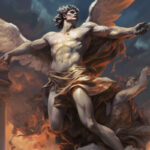Noir fiction, with its gritty, dark atmosphere and morally ambiguous characters, has captivated readers for decades, spawning countless films, TV shows, and novels. In this article, we’ll explore the history and defining elements of noir fiction, the genre’s golden age, and present the top 6 noir novels ever written. Get ready to dive into a world of seedy streets, hardboiled detectives, and twisted plots.

Defining Noir Fiction
Noir fiction is a subset of crime fiction, characterized by its gloomy, tragic atmosphere and emphasis on character development over plot. The term ‘noir’ – which means ‘black’ or ‘dark’ in French – was coined in the 1940s by French critics to describe the kinds of dark, morally ambiguous stories written by American authors at that time. These stories were often bleak and featured flawed protagonists whose motivations ranged from greed, desire, or revenge to simple survival.
Despite being a relative niche genre, noir fiction has had a significant impact on popular culture. From classic films like “The Maltese Falcon” and “Double Indemnity” to modern TV shows like “True Detective,” the influence of noir can be seen in a wide range of media.
Over the years, noir fiction has evolved and become more complex, while still retaining its distinctive feel. While some debate exists over the exact definition of noir fiction, several characteristics stand out as hallmarks of the genre.
Characteristics of Noir Novels
At the core of any good noir novel are the characters. Protagonists in noir stories are typically cynical, world-weary individuals with their own moral code, caught up in situations beyond their control. These characters may be private detectives, criminals, or ordinary people caught up in extraordinary circumstances. Regardless of their profession, they are often trapped in a web of deceit or betrayal, navigating a corrupt world in which nothing is as it seems.
One of the most interesting aspects of noir fiction is the way it explores the darker aspects of human nature. The characters in these stories are often flawed and morally ambiguous, making it difficult for readers to fully sympathize with them. However, this complexity is what makes them so compelling.
Aside from captivating characters, noir fiction also relies heavily on setting and atmosphere. The stories frequently take place in dense urban environments, such as the seedy underbellies of major cities like New York, Los Angeles, or San Francisco. The city itself becomes a character in these stories, with its dark alleys and hidden corners serving as the perfect backdrop for nefarious deeds.
Another essential element of noir fiction is the use of provocative, sensual language and imagery. The genre is known for its vivid descriptions of violence, sex, and other taboo subjects. This creates a sense of danger and excitement that draws readers in and keeps them engaged.
Finally, the genre is known for its complex, labyrinthine plots filled with unexpected twists and turns. The best noir stories keep readers guessing until the very end, with each new revelation adding another layer of intrigue.
The Evolution of Noir Fiction
While noir fiction has its roots in the works of authors such as Dashiell Hammett and Raymond Chandler, the genre has evolved significantly over time. With each new generation of writers, noir fiction has expanded to incorporate contemporary themes and settings, while still maintaining its core elements.
Modern authors, such as James Ellroy and Megan Abbott, continue the tradition of weaving intricate tales of crime, depravity, and debauchery against a backdrop of noir’s signature gloom. However, they also bring their own unique perspectives and voices to the genre, adding new layers of complexity and nuance.
Despite its dark subject matter, noir fiction remains a popular and enduring genre. Its ability to explore the darker aspects of human nature and society, while still providing a thrilling and engaging reading experience, ensures that it will continue to captivate readers for years to come.
The Golden Age of Noir (1940s-1950s)
In the 1940s and 50s, a wave of crime novels exploded onto the scene, marking the golden age of noir fiction. This period saw the emergence of some of the most influential writers in the genre and set the stage for the many great noir novels that would follow. Two key factors contributed to this golden age: the birth of hardboiled detective fiction and the influence of pulp magazines.
The Birth of Hardboiled Detective Fiction
Although hardboiled detective fiction shares some characteristics with classic detective stories (e.g., featuring an investigator solving a crime), the former is distinguished by its focus on darker, more realistic themes. The gritty, unsentimental world of hardboiled fiction, brought to life by authors such as Dashiell Hammett and Raymond Chandler, laid the groundwork for the emergence of noir.
These writers introduced iconic characters such as Sam Spade and Philip Marlowe, who became the archetypes for the hardboiled detective. Through their gripping novels, Hammett and Chandler solidified the foundations upon which many future noir novels would be built.
The hardboiled detective was a new kind of hero, one who was tough, cynical, and often morally ambiguous. These detectives were not afraid to get their hands dirty and were willing to bend the rules to get the job done. They were flawed, complex characters who were as likely to be the cause of their own problems as they were to solve them.
One of the most important aspects of hardboiled detective fiction was its use of language. The prose was spare and direct, with an emphasis on action and dialogue. The dialogue was often sharp and witty, reflecting the tough, streetwise characters who populated these stories.
The Influence of Pulp Magazines
Another significant factor in the golden age of noir was the popularity of pulp magazines, which became one of the primary vehicles for the dissemination of noir fiction. These magazines were named for their low-quality, “pulpy” paper and featured sensationalistic, often violent, crime stories. Writers like James M. Cain, Jim Thompson, and Cornell Woolrich published their work in these magazines, drawing the attention of the public to the darker, more nihilistic side of crime fiction.
The pulps provided a unique and fitting environment for the development of noir fiction. The combination of the hardboiled detective story’s fast pace and stylized prose with the intense, pessimistic outlook of the pulps fostered the rise of the noir genre.
One of the most interesting aspects of pulp magazines was their role in shaping American culture. These magazines were read by millions of people and had a significant impact on popular culture. They helped to create a new kind of hero, one who was tough, independent, and unafraid to take on the world.
However, the pulps were not without their critics. Many people saw them as cheap and exploitative, catering to the lowest common denominator. They were accused of promoting violence and immorality and were often the target of censorship campaigns.
Despite these criticisms, the pulps played a vital role in the development of noir fiction. They provided a platform for writers to experiment with new ideas and styles and helped to create a new kind of literature that spoke to the anxieties and fears of post-war America.
Another classic from James M. Cain, The Postman Always Rings Twice tells the story of a drifter who becomes embroiled in a deadly love triangle with a married woman and her husband. The novel’s raw, unflinching portrayal of violence and sexuality shocked readers when it was first published in 1934, but it has since become a beloved and influential work of noir fiction.
The Asphalt Jungle by W.R. Burnett
W.R. Burnett’s The Asphalt Jungle is a heist novel that follows a group of criminals as they plan and execute a daring robbery. But as the plan begins to unravel and tensions rise, the characters are forced to confront their own moral failings and the consequences of their actions. The novel’s gritty realism and complex characters make it a standout in the genre.
The Killer Inside Me by Jim Thompson
The Killer Inside Me is a chilling portrait of a small-town sheriff who is also a sociopathic killer. As he goes about his everyday business, the sheriff’s inner demons begin to surface, leading to a trail of brutal murders. Thompson’s novel is a disturbing exploration of the dark side of human nature and a must-read for fans of psychological thrillers.
The Long Goodbye by Raymond Chandler
In this novel, Philip Marlowe is hired to help a friend who is being blackmailed. But as Marlowe delves deeper into the case, he discovers a web of corruption and deceit that threatens to destroy everything he holds dear. The Long Goodbye is a masterful blend of mystery, suspense, and social commentary, and it cemented Chandler’s reputation as one of the greatest crime writers of all time.
Red Harvest by Dashiell Hammett
Red Harvest is a novel about a detective who is hired to clean up a corrupt town. As he begins to investigate, he finds himself embroiled in a web of violence and betrayal that threatens to consume him. Hammett’s novel is a brutal, uncompromising look at the dark side of human nature, and it remains one of the most influential works of noir fiction.
Farewell, My Lovely by Raymond Chandler
In this novel, Philip Marlowe is hired to find a missing woman, but the case quickly becomes more complicated than he anticipated. As he navigates a web of deceit and danger, Marlowe must confront his own demons and face the consequences of his actions. Farewell, My Lovely is a gripping and suspenseful novel that showcases Chandler’s unparalleled skill at crafting complex, multi-layered narratives.
The Glass Key by Dashiell Hammett
The Glass Key is a novel about a political boss and his right-hand man who becomes embroiled in a web of corruption and murder. As they struggle to maintain their power and protect their interests, they must also confront their own weaknesses and vulnerabilities. Hammett’s novel is a powerful meditation on the nature of power and the corrupting influence of ambition.
So there you have it, our list of the top 10 noir novels. Whether you’re a die-hard fan of the genre or just looking for a good read, these books are sure to satisfy your craving for suspense, intrigue, and gritty realism.
FAQs
What is noir fiction?
Noir novels typically follow dark themes such as crime or war but instead of following the ‘heroes’ (detectives, law enforcers, etc.) they use victims or perpetrators as their protagonists.
Is noir its own genre?
Noir is typically understood as a subgenre of thrillers or crime fiction. Although, some have gone as far as considering it to be its own genre.
Who are the most famous noir writers?
Patricia Highsmith and Raymond Chandler are both popular thriller writers known to have experimented with the noir subgenre.
- The 11 Best Books About Cats You Should Read - January 16, 2024
- The 9 Best Books on Building Confidence - January 16, 2024
- Discover the 10 Best Books on the Brain - January 16, 2024



